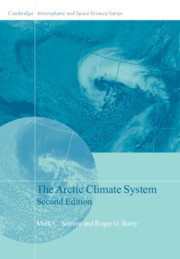Book contents
- Frontmatter
- Dedication
- Contents
- Preface
- Acknowledgments
- List of Acronyms
- List of Selected Web Sites
- 1 The Evolution of Knowledge about the Arctic and Its Climate
- 2 Physical Characteristics and Basic Climatic Features
- 3 The Basic Atmospheric and Ocean Energy Budgets
- 4 The Atmospheric Circulation
- 5 Energy Exchanges at the Surface
- 6 Precipitation, Net Precipitation, and River Discharge
- 7 Arctic Ocean–Sea Ice–Climate Interactions
- 8 Climate Regimes of the Arctic
- 9 Modeling the Arctic Climate System
- 10 Arctic Paleoclimates
- 11 The Uncertain Future
- References
- Index
- Plate Section
1 - The Evolution of Knowledge about the Arctic and Its Climate
Published online by Cambridge University Press: 05 August 2014
- Frontmatter
- Dedication
- Contents
- Preface
- Acknowledgments
- List of Acronyms
- List of Selected Web Sites
- 1 The Evolution of Knowledge about the Arctic and Its Climate
- 2 Physical Characteristics and Basic Climatic Features
- 3 The Basic Atmospheric and Ocean Energy Budgets
- 4 The Atmospheric Circulation
- 5 Energy Exchanges at the Surface
- 6 Precipitation, Net Precipitation, and River Discharge
- 7 Arctic Ocean–Sea Ice–Climate Interactions
- 8 Climate Regimes of the Arctic
- 9 Modeling the Arctic Climate System
- 10 Arctic Paleoclimates
- 11 The Uncertain Future
- References
- Index
- Plate Section
Summary
Overview
The land of the midnight sun has enchanted humankind for centuries. Rarely does a visitor to this unique and storied region leave without impressions that last a lifetime. Whether it is images of immense glaciers, the shifting pack ice under steel-gray skies, the Aurora Borealis, or bountiful wildlife grazing treeless, windswept tundra, the Arctic, even today, evokes images of a largely wild and untamed place. For many, the Arctic is as much a feeling as it is a region. Those with even a passing knowledge of it are familiar with the spirit of adventure – humans against nature – that drove some of the early exploration of the region. But the history of Arctic exploration and discovery is much more than Robert Peary’s glorified, albeit doubtful, conquest of the pole. The expeditions of Vitus Bering, John Franklin, Martin Frobisher, Henry Hudson, Fridjof Nansen, George Nares, Otto Sverdrup, Alfred Wegner, and others variously reflected nationalism, the shifting economic significance of the region, and scientific inquiry. Many of the geographic place names in the Arctic honor these explorers (Figure 1.1). To appreciate our present understanding of the Arctic, we need to step back and review some of this rich history over the past four or five centuries, recognizing, of course, that there have been indigenous populations in the Arctic for thousands of years.
- Type
- Chapter
- Information
- The Arctic Climate System , pp. 1 - 22Publisher: Cambridge University PressPrint publication year: 2014



